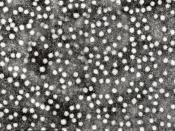There are many diseases these days that run rampant through the world; one of them is hepatitis. Hepatitis is an acute inflammation on the liver that is usually signaled by stomach upset and diarrhea. Other symptoms may include tenderness or pain in the upper abdomen and jaundice. Jaundice is a yellowing of the skin and whites of the eyes. There are many types of hepatitis, but there are two virus diseases in which hepatitis is the major effect. These two types are hepatitis A, or infectious hepatitis, and hepatitis B, or serum hepatitis. It is these two types that are usually referred to as hepatitis. Although there are two different types of hepatitis, their symptoms are virtually indistinguishable (Locke 81).
True hepatitis multiplies in the intestine and then passes out in the stools with out ever managing to reach the liver. Such infections are inapparent. Hepatitis A is slightly different.
It is a virus that multiplies in the intestine, and then finds its way to the liver by the way of the blood stream. Signs of pre-jaundice occur due to intestinal multiplication. When jaundice and other late signs occur it means that the liver is being attacked. Hepatitis A was found by microscope examinations of stools in nineteen seventy-three. So far a vaccine has not been able to be produced, but recent studies have helped somewhat. Researchers have failed to grow hepatitis A virus in hens' eggs or tissue culture. This step is imperative to make a vaccine. Recently the virus has been found to infect marmosets, a kind of South American monkey, and this is the first known animal host other than man. Using both antibodies and viruses from marmosets, lab workers can now use serological tests to confirm the presence of hepatitis A. This development makes a...


